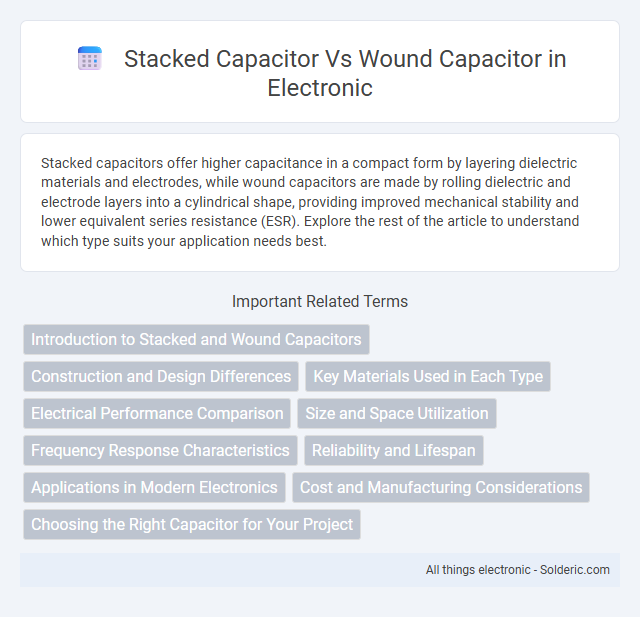Stacked capacitors offer higher capacitance in a compact form by layering dielectric materials and electrodes, while wound capacitors are made by rolling dielectric and electrode layers into a cylindrical shape, providing improved mechanical stability and lower equivalent series resistance (ESR). Explore the rest of the article to understand which type suits your application needs best.
Comparison Table
| Feature | Stacked Capacitor | Wound Capacitor |
|---|---|---|
| Construction | Multiple dielectric layers stacked vertically | Dielectric and foil wound in a spiral or cylindrical shape |
| Size | Compact, flat form factor | Typically larger and cylindrical |
| Capacitance Range | Low to medium capacitance | Medium to high capacitance |
| Voltage Rating | Moderate voltage tolerance | High voltage capability |
| ESR (Equivalent Series Resistance) | Low ESR | Moderate to high ESR |
| Frequency Response | Better high-frequency performance | Limited high-frequency performance |
| Applications | High-frequency circuits, RF applications | Power electronics, filtering, energy storage |
| Manufacturing Complexity | More complex layering process | Relatively simpler winding process |
Introduction to Stacked and Wound Capacitors
Stacked capacitors consist of multiple dielectric layers separated by metal electrodes, which enhance capacitance density and improve frequency performance, making them ideal for integrated circuits and high-frequency applications. Wound capacitors are made by rolling alternating layers of metal foil and dielectric film into a cylindrical shape, providing high capacitance values in a compact form suitable for power electronics and filtering circuits. Both types exhibit distinct structural advantages tailored to specific electronic applications, with stacked capacitors favoring miniaturization and wound capacitors excelling in energy storage.
Construction and Design Differences
Stacked capacitors consist of multiple layers of dielectric and electrode materials laminated together, providing a compact, high-capacitance structure ideal for miniaturized electronic circuits. Wound capacitors are constructed by rolling a long dielectric film and metal foil into a cylindrical shape, resulting in a larger, more robust design suitable for high-voltage applications. The layered lamination in stacked capacitors offers superior volumetric efficiency, while the rolled design of wound capacitors allows for better mechanical flexibility and heat dissipation.
Key Materials Used in Each Type
Stacked capacitors primarily use dielectric materials such as ceramic, tantalum, or aluminum oxide combined with metal electrodes like aluminum or tantalum foil to achieve high capacitance in a compact form. Wound capacitors typically consist of metalized film dielectrics such as polyester, polypropylene, or polycarbonate, with aluminum or zinc foil electrodes rolled into a cylindrical shape. The choice of dielectric and electrode materials directly influences the capacitor's performance characteristics, including voltage rating, capacitance stability, and equivalent series resistance (ESR).
Electrical Performance Comparison
Stacked capacitors exhibit superior electrical performance in high-frequency applications due to their lower equivalent series resistance (ESR) and reduced inductance compared to wound capacitors. Wound capacitors typically have higher parasitic inductance arising from their coil structure, which limits their effectiveness in high-speed circuits. The lower ESR and inductive characteristics of stacked capacitors enable improved signal integrity and power efficiency in modern electronic devices.
Size and Space Utilization
Stacked capacitors offer a compact design by layering dielectric materials and electrodes vertically, maximizing capacitance while minimizing footprint, which is ideal for applications with limited space. Wound capacitors use a rolled construction that occupies more volume but can handle higher voltages and provide greater capacitance stability under varying conditions. Your choice depends on whether space efficiency or performance under stress is the priority in your electronic design.
Frequency Response Characteristics
Stacked capacitors exhibit superior frequency response characteristics due to their lower equivalent series inductance (ESL) and resistance (ESR), enabling effective performance at high frequencies. Wound capacitors typically have higher ESL, resulting in increased impedance and reduced efficiency as frequency increases. Therefore, stacked capacitors are preferred in high-frequency filtering and decoupling applications where minimal signal degradation is critical.
Reliability and Lifespan
Stacked capacitors offer higher reliability due to their solid construction, which reduces the risk of mechanical failure and improves thermal stability compared to wound capacitors. Wound capacitors, with their layered foil and dielectric arrangement, may experience higher susceptibility to physical damage and moisture ingress, potentially shortening their lifespan. Advanced materials and manufacturing techniques in stacked capacitors contribute to extended operational life and consistent performance under varying environmental conditions.
Applications in Modern Electronics
Stacked capacitors are widely used in high-frequency circuits and compact power supply designs due to their superior capacitance density and thermal stability, making them ideal for smartphones, laptops, and electric vehicles. Wound capacitors excel in applications requiring high voltage ratings and energy storage, such as power conditioning, audio amplifiers, and industrial motor drives, thanks to their robust construction and reliable performance. Modern electronic devices leverage the small size and efficiency of stacked capacitors while relying on wound capacitors for durability in high-stress environments.
Cost and Manufacturing Considerations
Stacked capacitors generally incur higher manufacturing costs due to complex layering processes and precision alignment requirements, impacting overall production expenses. Wound capacitors offer cost advantages by utilizing simpler winding techniques that streamline assembly and reduce labor time. Your choice between the two should consider budget constraints alongside the required capacitance and size, as stacked designs are premium but smaller, whereas wound capacitors are often more economical and easier to manufacture.
Choosing the Right Capacitor for Your Project
Stacked capacitors offer higher capacitance values and better voltage handling in a compact size, making them ideal for applications requiring efficient energy storage and space-saving designs. Wound capacitors, with their layered construction, deliver superior stability and low inductance, suited for high-frequency circuits and precision filtering. Evaluating your project's specific voltage, capacitance, and frequency needs will help you select the right capacitor type to optimize performance and reliability.
stacked capacitor vs wound capacitor Infographic

 solderic.com
solderic.com